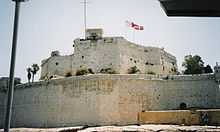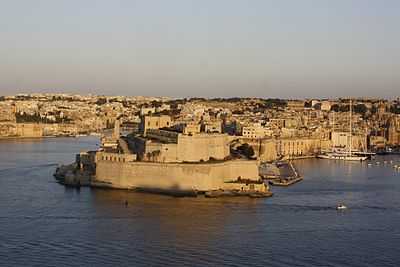Fort St Angelo
| Fort Saint Angelo | |
|---|---|
| Birgu, Malta | |
|
View of Fort Saint Angelo as seen from Valletta. | |
| Coordinates | 35°53′31″N 14°31′6″E / 35.89194°N 14.51833°E |
| Type | Coastal fortification and part of a city wall |
| Site information | |
| Owner |
|
| Open to the public | No |
| Condition | Intact |
| Site history | |
| Built | 13th century-1690s |
| Built by | Order of Saint John |
| In use | 13th century-1979 |
| Materials | Limestone |
| Battles/wars |
Battle of Malta Invasion of Gozo Siege of Malta (1565) Siege of Malta (1798–1800) Siege of Malta (World War II) |
Fort Saint Angelo is a large fortification in Birgu, Malta, right at the centre of Grand Harbour. It is not known exactly when it was first built, but it definitely existed by the 13th century. It was originally known as the Castrum Maris until it was rebuilt by the Order of Saint John as Fort Saint Angelo in the 16th century. The fort was then used by the British as a stone frigate, and was known as HMS Egmont or later HMS St Angelo. It was last used for military purposes in 1979, and in 1998 part of it was handed back to the SMOM. The fort is currently being restored.[1]
History
Medieval times
The date of its original construction is unknown. However, there are claims of prehistoric or classical buildings near the site, due to some large ashlar blocks and an Egyptian pink granite column at the top part of the fort. There is also the mentioning in Roman texts of a temple dedicated to Juno/Astarte, probably in the vicinity of the fort. There is also the popular attribute to its foundation to the Arabs, c. 870 AD, but nothing is concrete although al-Himyarī mentions that the Arabs dismantled a hisn (fortress), but there is no actual reference if this 'fortress' was in Vittoriosa. Its probable start as a fortification is the high/late medieval period. In fact, in 1220 Hohenstaufen Emperor Frederick II started to appoint his own Castellani for Malta who needed a place to live and secure the interests of the crown. The remains of a tower that may date back to the 12th century can be traced among the more recent works. The first mention of Castrum Maris ("Castle by the sea") is to be found in documents from the 1240s when Paulinus of Malta was the lord of the island and later when Giliberto Abate made a census of the islands. Another reference to the castle is that from the short Angevin rule (1266–83) where documents list it again as Castrum Maris and list a garrison of 150 men together with several weapons. It seems also that by 1274, the castle already had two chapels which are still there today. From the same year exists also a detailed inventory of weapons and supplies in the castle. From 1283 the Maltese islands were under Aragonese rule (although the castle withstood for some time in Angevin rule while the rest of Malta was already in Aragonese hands) and the fortification was mainly used by Castellani (like the de Nava family) who were there to safeguard the interests of the Aragonese crown. In fact the Castellans did not have any jurisdiction outside the ditch of the fort.
Knights' period
When the Knights of Malta arrived in Malta in 1530, they chose to settle in Birgu, and Fort St Angelo became the seat of the Grand Master, which included the refurbishing of the Castellan's House and St. Anne's Chapel. The Knights made this their primary fortification and substantially reinforced and remodelled it, including the cutting of the dry ditch to make it a moat and the D'Homedes Bastion built by 1536. By 1547, a large cavalier designed by Ferramolino was built behind the D'Homedes bastion and also the construction of the De Guirial battery right at the tip of the fort by sea level to protect the entrance to Dockyard Creek. These works transformed the fort into a gunpowder fortification. Fort St Angelo withstood the Turks during the Great Siege of Malta, during which it succeeded in tearing apart a sea attack by the Turks on Senglea on 15 August 1565.[2] In the aftermath of that siege, the Knights built the fortified city of Valletta on Mount Sciberras on the other side of the Grand Harbour, and the administrative centre for the knights moved there. It was not until the 1690s that the fort again underwent major repairs. Today's layout of the fort is attributed to these works which were designed by Carlos de Grunenburgh, who also paid for the construction of four gun batteries on the side of the fort facing the entrance to Grand Harbour. As a result, one can still see his coat of arms above the main gate of the fort. By the arrival of the French in 1798, therefore, the fort became a very powerful fortification including some 80 guns, 48 of which pointed towards the entrance of the port. During the short two-year period of French occupation, the Fort served as headquarters of the French Army.
British period
With the coming of the British to Malta the fort retained its importance as a military installation, first in use by the Army. In fact, in 1800, two battalions of the 35th Regiment were resident in the fort. However, at the start of the 20th century, the fort was taken over by the Navy and it was listed as a ship, originally in 1912 as HMS Egmont,[3] when it became a base for the Royal Navy in the Mediterranean, but in 1933 renamed as HMS St Angelo. The British did not make many modifications to the fort, although they built a casemated battery for three nine-inch RML guns in the 19th century and also a cinema and a water distillation plant in the early 20th century. During World War II, the fort again stood for siege with an armament of 3 Bofors guns (manned by the Royal Marines and later by the Royal Malta Artillery). In total, the fort suffered 69 direct hits between 1940 and 1943. When the Royal Navy left Malta in 1979 the Fort was handed to the Maltese government and since then parts of the Fort have fallen into a state of disrepair, mostly after a project to transform it into a hotel during the 1980s.
Present day

On 5 December 1998, a treaty was signed between Malta and the Sovereign Military Order of Malta granting the upper part of Fort St Angelo, including the Grand Master's House and the Chapel of St Anne, to the Order with limited extraterritoriality. Its stated purpose is "to give the Order the opportunity to be better enabled to carry out its humanitarian activities as Knights Hospitallers from Saint Angelo, as well as to better define the legal status of Saint Angelo subject to the sovereignity of Malta over it".
This treaty was ratified on 1 November 2001.[4] The agreement has a duration of 99 years but the document allows the Maltese Government terminate it at any time after 50 years.[5][6] In terms of the agreement, the flag of Malta is to be flown together with the flag of the Order in a prominent position over Saint Angelo. No asylum may be granted by the Order and generally the Maltese courts have full jurisdiction and Maltese law shall apply. A number of immunities and privileges are mentioned in the second bilateral treaty.
Other parts of the fort are leased to the Cottonera Waterfront Group, a private consortium.[7][8]
On 5 March 2012, it was confirmed that the European Regional Development Fund allocated €13.4 million for the restoration, conservation and re-use of the site, which will see the Fort opened as a major visitor attraction highlighting its history and roles through the ages as well as to cater for educational programs, cultural events and live historical experiences. The restoration is being managed by Heritage Malta.[9][10]
The fort is currently closed to the public.
Burials
The following Grandmasters were all originally buried in the chapel of Fort Saint Angelo:
- Philippe Villiers de L'Isle-Adam (died 1534)
- Piero de Ponte (died 1535)
- Juan de Homedes y Coscon (died 1553)
- Claude de la Sengle (died 1557)
However, their remains were relocated to the crypt of St. John's Co-Cathedral in the late 16th century.[11]
Gallery
-

Fort St Angelo as seen from Valletta
-

West face of the fort, from Dockyard Creek
-

Main Gate
-

Inscription over the gate
-

West face of the seaward bastion
-

Chapel
-

The fort from Senglea
References
- ↑ Wallace, RMM. International Law, 2nd edition, London 1992. Sweet & Maxwell. p. 76.
- ↑ Spiteri, Stephen C. "Fort St Angelo during the Great Siege". Military Architecture. Retrieved 16 September 2014.
- ↑ "Fort St Angelo". Lonely Planet. Retrieved 16 September 2014.
- ↑ "Agreement between the Government of Malta and the Government of the Sovereign Hospitalier Order of Saint John of Jerusalem, of Rhodes and of Malta for the restoration and utilisation of parts of Fort St. Angelo". Ministry of Foreign Affairs. Retrieved 16 September 2014.
- ↑ "The Order and its Institutions - Mission". Sovereign Military Order of Malta. Retrieved 26 December 2011.
- ↑ "After two centuries, the Order of Malta flag flies over Fort St. Angelo, beside the Maltese flag". Sovereign Military Order of Malta. 13 March 2001. Retrieved 16 September 2014.
- ↑ "Heritage Malta wants to transform Fort St Angelo into a cultural experience". Times of Malta. 3 September 2010. Retrieved 30 July 2011.
- ↑ "Restoration of Fort St Angelo underway". Military Architecture. 8 September 2010. Retrieved 16 September 2014.
- ↑ "Funds available at last for Fort St Angelo restoration". Times of Malta. 5 March 2012. Retrieved 5 March 2012.
- ↑ "Progress being made in Fort St Angelo restoration". Times of Malta. 2 April 2013. Retrieved 16 September 2014.
- ↑ Mallia-Milanes, Victor (2008). The Military Orders: History and heritage. Aldershot: Ashgate Publishing Limited. p. 62. ISBN 9780754662907. Retrieved 31 October 2014.
External links
| Wikimedia Commons has media related to Fort St. Angelo. |
- Photosynth of Fort St Angelo – A photosynth of Fort St Angelo
| ||||||||||
